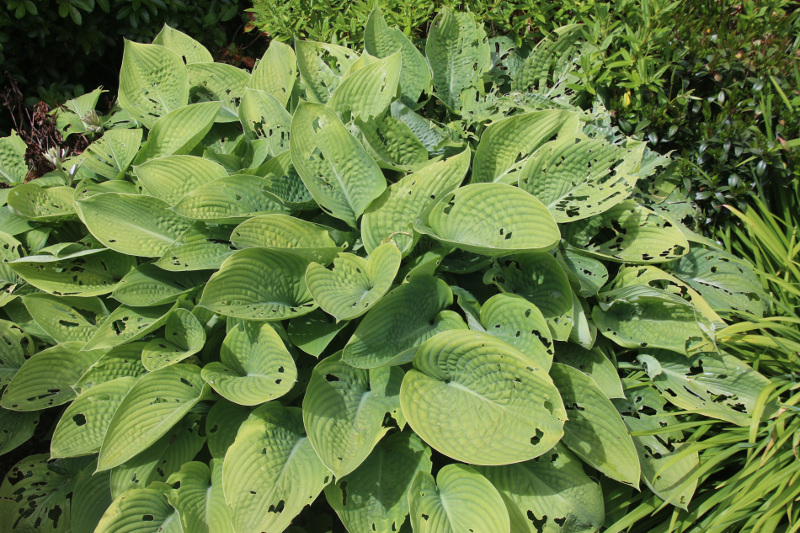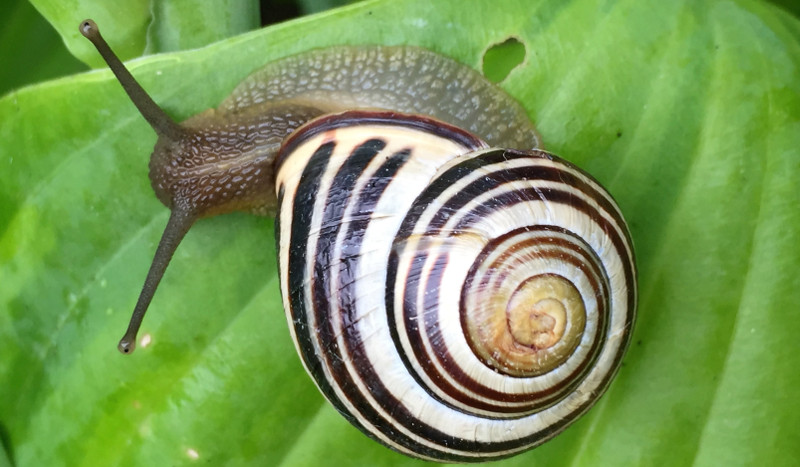Slugs are the number 1 problem for gardeners trying to grow hostas. The plants are a favorite food for slugs and snails and are a very common problem to deal with. Read below to identify if slugs are the problem and how to control the slugs if that is the issue.
How Do You Tell If Slugs Are Eating Hostas?
The most common way to tell if you have a slug problem is having tiny holes in the foliage, specifically the leaves. The holes can be from small to large in size and will have irregular shapes. When the slug population is large, the damage done can be quite considerable.

Slugs will be active when temperatures are above 50 degrees and at night or during cloudy days. When not active during the day, slugs will be hiding within crevices around the plants like in the mulch, dirt or under and in between rocks. Slugs also require a lot of moisture in whichever area they decide to live at.
Damage that is done late in the eason may not be as stressful on the plants compared to damage done by slugs earlier in the year. So it sometimes makes sense to just accept the damage done and wait until the following year to do anything about it. Small damage done isn’t as concerning and only impacts the aesthetics and appearance of the plant but not the plant's health.
How Do I Stop Slugs From Eating Hostas?
Depending on where you live, slugs may just be a way of life in your area or growing zone. So it is best to be diligent to prevent slugs so you don’t end up with poor looking hostas, or your hostas aren’t completely eaten, get sick and die completely. There are several methods and myths out there to either work as deterrents, control, or kill the slugs. We’ve tried our best to find the best ways and also to mythbust methods floating out there that flat out won’t work.

If you notice snail damage, we recommend taking the following steps immediately:
Step 1 - clean up the garden area to try and remove any areas where slugs can be hiding. This includes mulch, leaves, and other debris commonly found in the garden. Thoroughly rake up the area and replace the debris with new mulch if warranted.
Step 2 - when watering, be sure to do so in the morning. That way the beds will hopefully be drier at night by the time the slugs become active again.
Step 3 - you may want to consider thinning or dividing the hostas if your garden is crowded. You can skip this step if you prefer your garden to be full of plants instead of a well-manicured garden.
Step 4 - small slug infestations can sometimes be controlled by simply picking them off the leaves at night. Use a flashlight at night to spot them. Pick off any that you see and be sure to check around the base of the plants, where they like to often hide.
Step 5 - in the spring, redo step 1 and rake and remove any debris around the plants. This will help remove any slug eggs before they hatch.
Once you feel good about those steps, there are other more drastic measures you can take, both natural and with chemicals depending on your preference.
Don’t forget to check the companion plants while you are at it, as slugs will eat more than just hostas, including nasturtiums, verbena, marigolds, delphiniums, dahlias, zinnias and many other plants.
Natural Ways To Control Slugs On Hostas
There are many home remedies that help prevent slugs from eating your hosta leaves. Some of the most popular ways are coffee, beer, citrus fruit, and egg shells.
Also, some natural predators can help control the slug population, including frogs, toads, birds like wrens, possums and beetles. Encouraging these animals to live in your garden by creating habitats that are conducive for those animals is a great natural way to control slugs.
Using Beer
The most common natural way to trap slugs is to use beer. Get a plastic cup and place it next to the plants, and fill the cup half way with beer. The slugs will be attracted to the beer, climb into the cup and drown.
Using Coffee
Sprinkle used coffee grounds around the plants. The caffeine in the grounds is actually poisonous to the slugs. It also acts as a natural fertilizer for the plants as an added bonus! Coffee will need to be reapplied every so often as the coffee disintegrates.
Using Citrus Fruit
You can either use old/used orange peels or any other cheap citrus. Place the pieces of citrus near the impacted plants. The slugs will leave the plants and go inspect the new treat. You can throw the spent rinds into the compost pile after you remove the slugs of course.
Using Cucumbers
Leaving slices of cucumbers by the plants you don’t want the slugs to eat may seem counter-productive. But, providing another source of food for the slugs will help save the hostas and other plants, at least long enough to catch the slugs and dispose of them. Similar to citrus, you can throw the used up pieces of cucumber in the compost after you remove the slugs.

Chemical Options to Kill Slugs
If the natural ways don't work there are a few options that you can try to kill the slugs. We always recommend trying organic ways first, because that is what is best for the environment. But sometimes using chemicals is the only sure-fire way to deal with the problem unfortunately.
Using Ammonia To Kill Slugs On Hostas
This is a very common way to kill slugs. Mix a 10 to 1 ratio (water to ammonia mix) and a sprayer to spray directly on the slugs and leaves of the hostas. It should kill the slugs on contact. It also acts as a fertilizer putting nitrogen. Make sure to spray all the way to the stems. Slugs will sometimes chew holes into the stem, so the entire leaf falls to the ground for an easy meal to devour. It works best to do this in the evening as slugs are out and do it when it isn’t extremely hot outside.
Using Sluggo
This is a pet safe and natural slug killer that you can purchase on Amazon or at a local hardware store. Apply according to directions on the bottle. There are many positive reviews for this product of successful gardeners controlling their slug populations with this.
Methods That Do NOT Work To Control Slugs
-Cornmeal doesn't bother slugs. In France it is actually fed to the snails they use for escargot.
-Crush egg shells up and place around the plants. Slugs do not like to move over sharp objects, so the edges of the egg shells help keep the slugs away. This is a myth, and there are videos of slugs moving over crushed shells with no issues.
Best Methods For Slug Control on Hostas
- Clean up the area around the plants of any debris
- Hand pick the slugs off the plants at night
- Use traps or chemicals to kill the rest of the slugs
Are There Slug Resistant Hostas?
Slugs and snails do prefer some hostas over others. However, no hostas are slug proof if the bugs are hungry enough. Plants with thicker leaves and with textured foliage are said to be less preferential to slugs compared to hostas that are thin leafed and smooth. The thick leaves are more resistant to slug damage. White/cream colored sections of the variegated leaves are thinner than the green sections therefore, the slug damage shows up better on the white.
Have you tried any other methods that work well? Or have you been unsuccessful trying any methods? Please email us at info@plantaddicts.com and let us know! We would be happy to add it to this list to help other gardeners out!
Sources: "Hosta Slugs." Illinois Extension. extension.illinois.edu
 |
Author Chris Link - Published 10-27-2020 |
